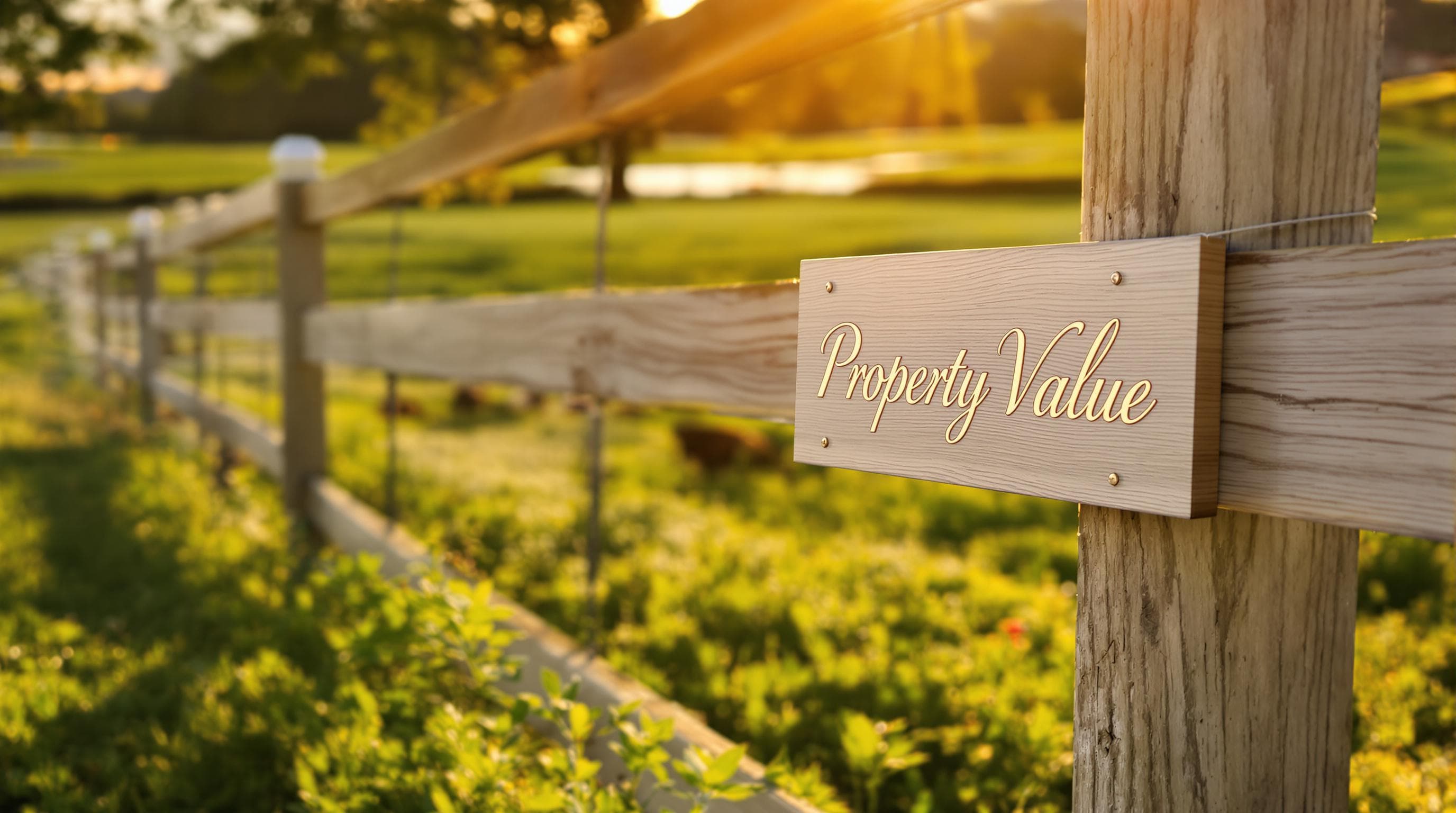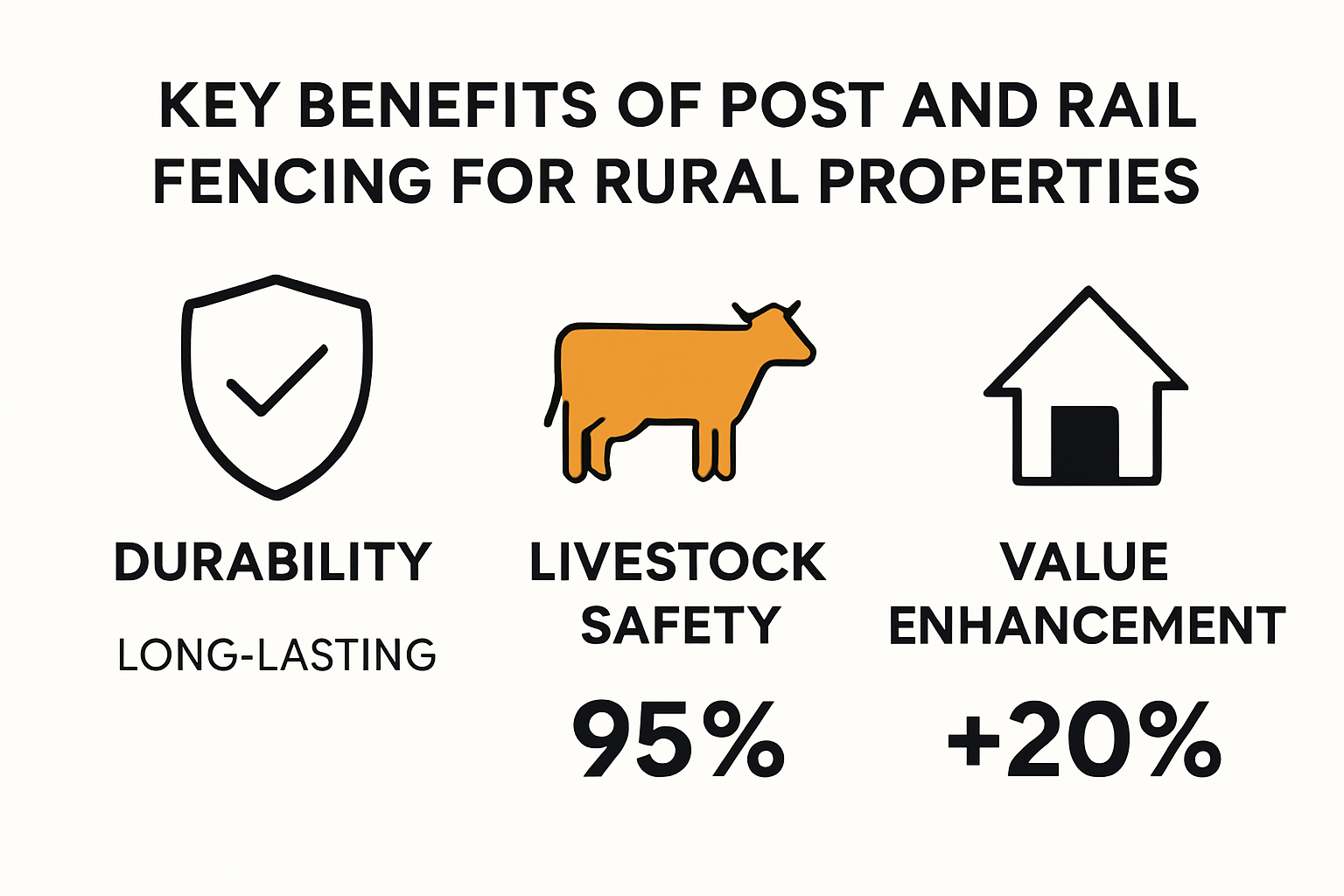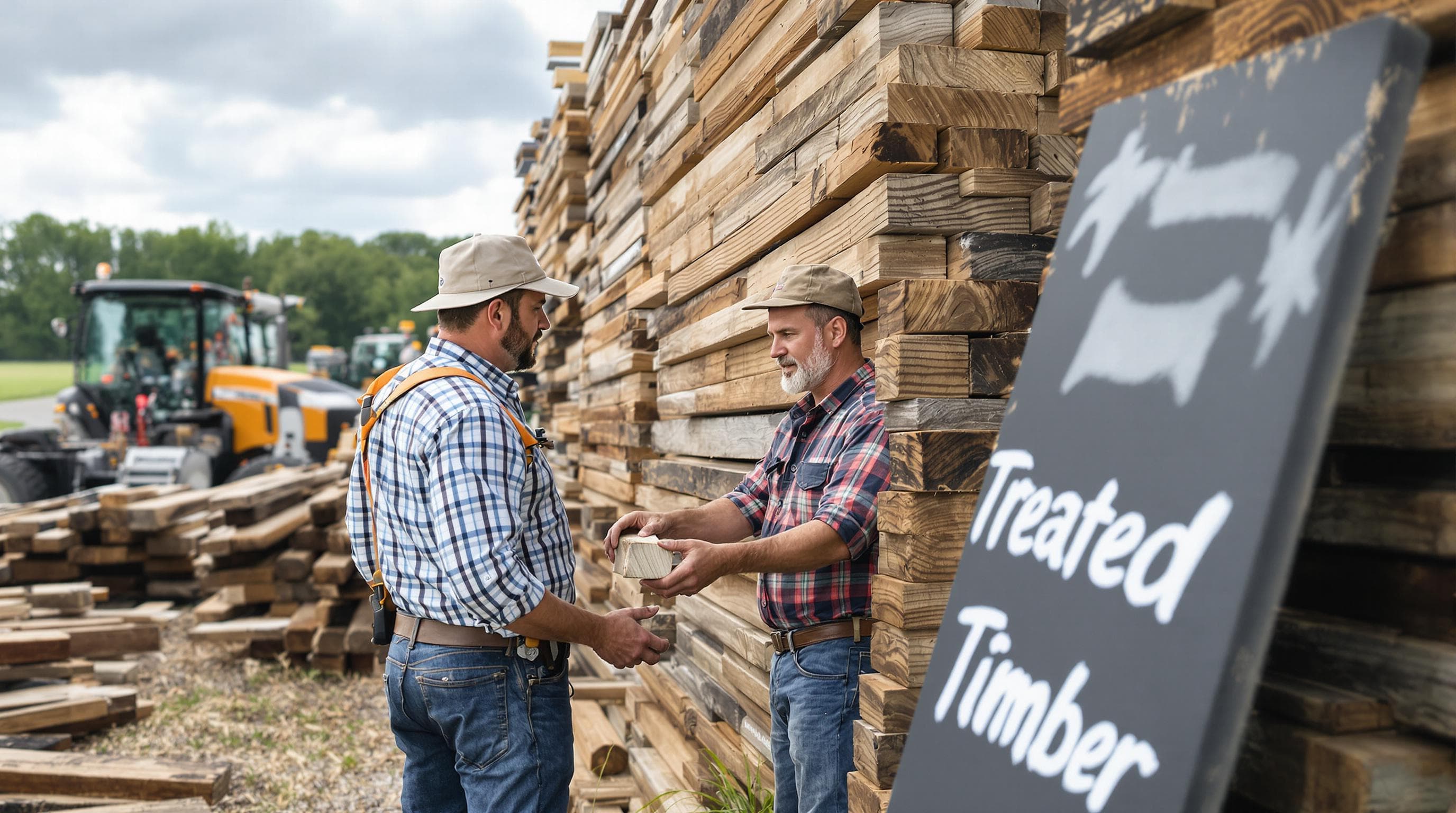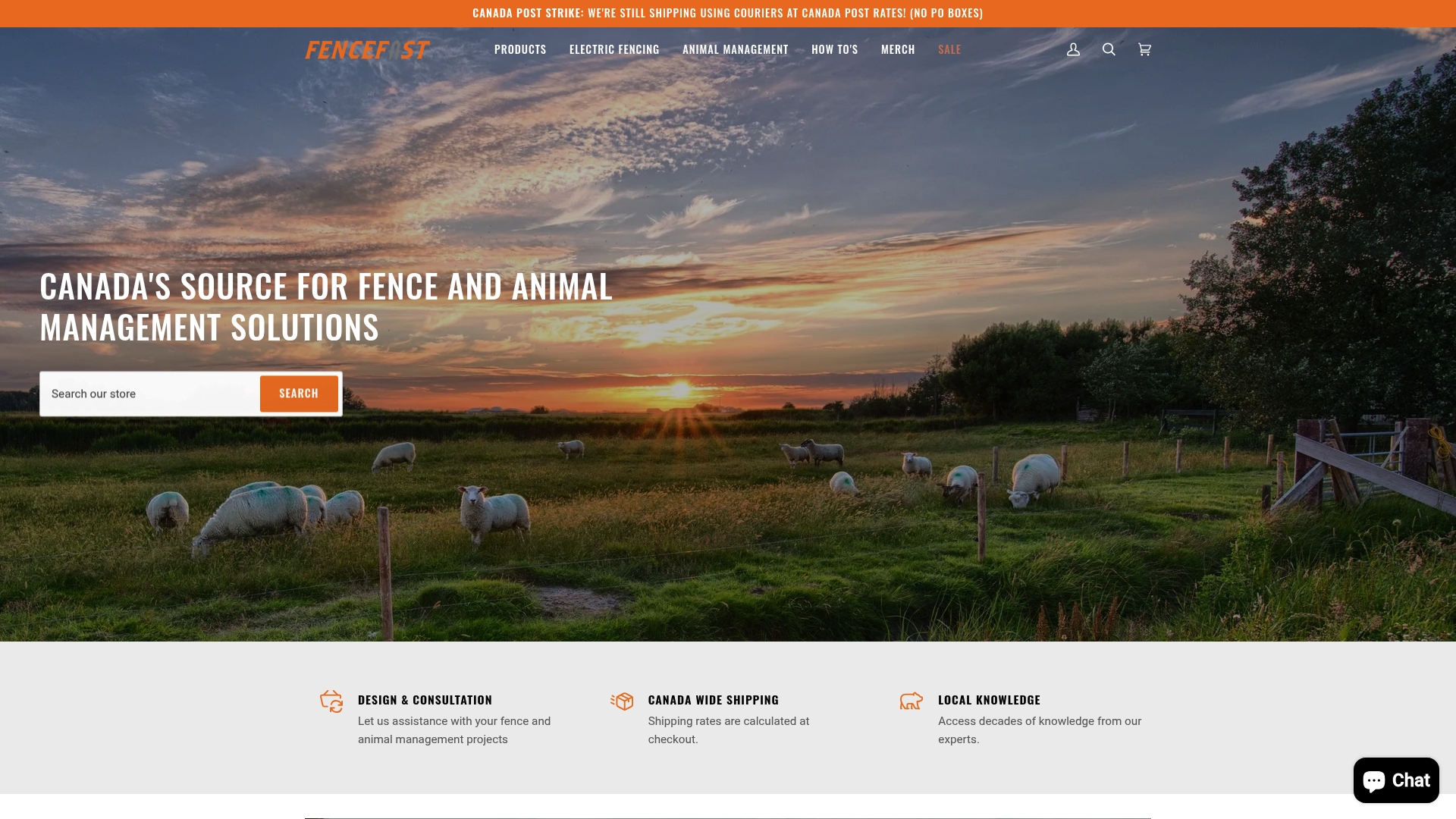
Post and rail fencing is quickly becoming the top choice for rural property owners, thanks to its classic style and reliable performance. Surprisingly, it is not just tradition driving this trend. Properties with well-maintained post and rail fences have seen up to a 10 percent increase in resale value. The real edge comes from how these fences blend both functionality and aesthetics, turning a simple boundary into a lasting investment.
Table of Contents
- Benefits Of Post And Rail Fencing In Rural Areas
- Choosing The Right Materials And Styles
- Installation Tips For Farmers And Contractors
- Maintenance And Long-Term Value For Livestock Owners
Quick Summary
| Takeaway | Explanation |
|---|---|
| Prioritize durability for livestock safety. | Post and rail fencing provides a strong barrier, minimizing injury risks for animals and lasting through harsh weather conditions. |
| Use treated timber for longevity. | Selecting H4 and H3 treated timber ensures protection from decay and enhances the fence’s lifespan and performance. |
| Implement regular maintenance checks. | Conduct quarterly inspections to identify wood decay, structural damage, and ensure continued integrity of the fence. |
| Choose a suitable construction style. | Inline construction offers stronger joints, while side-mounted is more economical; consider your livestock and landscape. |
| Invest in aesthetic appeal to boost property value. | Well-maintained post and rail fences enhance the visual appeal of rural properties, attracting potential buyers and increasing resale value. |
Benefits of Post and Rail Fencing in Rural Areas
Post and rail fencing represents a fundamental solution for rural property management, offering distinct advantages that make it an essential choice for farmers, ranchers, and rural landowners. These traditional fencing systems provide more than just boundary demarcation they create functional and aesthetic infrastructure critical for effective land and livestock management.
Durability and Livestock Safety
One of the most significant benefits of post and rail fencing is its exceptional durability and inherent safety for livestock. The Food and Agriculture Organization highlights that these fences are particularly effective in high-density animal areas, with a crucial advantage being the minimal risk of animal injury. The sturdy construction using wooden posts and horizontal rails creates a robust barrier that can withstand significant environmental challenges while providing a smooth surface that prevents animals from getting caught or injured.
The structural integrity of post and rail fencing means it can endure harsh weather conditions, from intense summer heat to freezing winter temperatures. Wooden materials naturally expand and contract, which helps them resist cracking and structural failure over time. This resilience translates to lower maintenance costs and longer fence lifespans compared to more fragile fencing alternatives.

Versatile Agricultural Applications
Agricultural fencing research demonstrates that post and rail systems offer remarkable versatility across different rural settings. These fences are not just boundary markers but functional infrastructure that can serve multiple purposes. They effectively contain livestock in designated areas, prevent wildlife intrusion, and can be strategically placed to manage grazing patterns and land use.
For ranchers managing diverse livestock populations, post and rail fencing provides a uniform solution that works equally well for cattle, horses, and other farm animals. The horizontal rail design creates a clear visual boundary that animals quickly learn to respect. This psychological barrier is often as effective as the physical fence itself, reducing the likelihood of animals attempting to breach the boundary.
Aesthetic and Property Value Enhancement
Beyond their practical applications, post and rail fences contribute significantly to rural property aesthetics. Their classic design evokes a sense of traditional agricultural heritage while simultaneously providing a clean, organized appearance to land boundaries. The natural wood materials blend seamlessly with rural landscapes, creating a visually appealing transition between different property sections.
Moreover, well-constructed post and rail fencing can increase property value. Potential buyers recognize these fences as a sign of thoughtful land management and appreciate the immediate visual appeal. The investment in quality fencing signals to observers that the property has been carefully maintained, which can be a crucial factor in rural real estate transactions.
Choosing post and rail fencing is more than a practical decision it is an investment in your property’s functionality, safety, and long-term value. By understanding these comprehensive benefits, rural property owners can make informed decisions that support their agricultural and land management goals.
Choosing the Right Materials and Styles
Selecting the appropriate materials and styles for post and rail fencing requires careful consideration of multiple factors that impact long-term performance, durability, and aesthetic appeal. Rural property owners must evaluate various options to ensure their fencing solution meets specific agricultural and environmental requirements.
Timber Selection and Treatment
WoodSolutions emphasizes the critical importance of timber preservation for fencing materials. Professional recommendations include using preservative-treated timber with specific protection levels. For fence posts, H4 level treatment provides maximum protection against environmental degradation, while H3 level treatments work effectively for rails and supplementary components.
Wooden posts represent the traditional choice for post and rail fencing. Hardwood species like cedar, oak, and treated pine offer exceptional durability and natural resistance to decay. These materials withstand significant environmental stress while maintaining structural integrity. Property owners should prioritize timber sourced from sustainable forestry practices to balance ecological responsibility with functional requirements.
Construction Styles and Design Considerations
The U.S. Forest Service’s Equestrian Design Guidebook highlights two primary post-and-rail construction approaches. Inline construction represents a more professional and structurally robust method, featuring rails precisely integrated through post holes. This technique creates stronger joints and a more refined appearance. Alternatively, side-mounted rails offer a more economical approach but may compromise structural stability.
Modern post and rail fencing designs accommodate various mounting techniques. Some configurations allow for rails measuring up to 16 feet in length, drilled directly through posts to create seamless connections. This approach minimizes potential weak points and enhances overall fence strength. Property owners should consider factors like terrain, livestock type, and anticipated environmental challenges when selecting a specific design style.

Alternative and Innovative Materials
Beyond traditional wooden materials, innovative alternatives are emerging in rural fencing solutions. The U.S. Forest Service’s Riparian Restoration guide highlights plastic lumber as a compelling option for posts and rails. This material offers significant advantages including complete resistance to rot, staining, and insect damage. Recommended plastic lumber should be 100% synthetic with no wood additives to maximize durability and longevity.
Emergent materials like composite and recycled plastic provide additional alternatives to traditional wooden post and rail fencing. These options deliver consistent performance with reduced maintenance requirements. Composite materials blend synthetic and organic components to create fencing solutions that resist environmental degradation while maintaining aesthetic appeal.
Choosing the right materials and styles for post and rail fencing involves balancing practical requirements with aesthetic preferences. Rural property owners must consider factors like local climate, livestock needs, budget constraints, and long-term maintenance expectations. By carefully evaluating available options and understanding the strengths of different materials, property owners can develop fencing solutions that provide reliable performance and visual harmony with their rural landscape.
To help you understand the strengths and differences among post and rail materials and construction methods, here is a comparison table summarizing the key attributes discussed above:
| Option | Key Features | Durability | Maintenance Level | Aesthetic Appeal |
|---|---|---|---|---|
| Timber (H4/H3 treated) | Traditional, natural wood, treated | High (with treatment) | Moderate | High (classic look) |
| Plastic Lumber | 100% synthetic, rot/insect-proof | Very High | Low | Medium (modern look) |
| Composite/Recycled | Synthetic/organic blend, eco-friendly | High | Low | Medium-High |
| Inline Construction | Rails through post holes, strong joints | High | Moderate | High (refined) |
| Side-mounted Construction | Rails mounted to sides, economical | Moderate | Moderate | Medium |
Installation Tips for Farmers and Contractors
Successful post and rail fencing installation requires precision, planning, and adherence to professional standards. Farmers and agricultural contractors must approach the project with careful consideration of technical specifications, terrain challenges, and long-term performance requirements.
Foundational Preparation and Post Placement
The Crofting Agricultural Grant Scheme provides critical guidance for post installation. Straining posts should be a minimum of 2.1 meters in length, with diameters carefully selected based on specific fence design requirements. Proper spacing is crucial strategic placement of straining posts at centers not exceeding 150 meters ensures structural integrity.
Before installation, conduct a thorough site assessment. Evaluate ground conditions, slope, drainage patterns, and potential obstacles. Clear the proposed fence line of vegetation, rocks, and debris. Precise ground preparation prevents future alignment issues and reduces long-term maintenance challenges. Consider using string lines or laser levels to maintain straight fence lines across uneven terrain.
Technical Installation Techniques
Farmers Weekly recommends running a single strand of plain wire between straining posts as a guide for intermediate post placement. This technique helps highlight ground undulations and ensures consistent alignment. High-tensile fencing offers significant advantages, allowing tighter straining and reducing post requirements compared to traditional mild steel alternatives.
When securing rails, use barbed staples for superior wood grip. These specialized fasteners minimize the risk of staples being pulled out over time, providing more reliable connections. Ensure staples are driven at slight angles to maximize holding strength. For wooden posts, pre-drilling pilot holes can prevent splitting and facilitate smoother installation.
Equipment and Safety Considerations
The UK Countryside Stewardship Grants emphasize the importance of using pressure-treated softwood timber that meets BS8417:2014 standards. This ensures your posts have appropriate protection against environmental degradation. Select timber treatments compatible with your specific agricultural environment, considering factors like moisture levels, soil composition, and potential pest exposure.
Prioritize safety during installation. Wear appropriate personal protective equipment, including sturdy gloves, safety glasses, and steel-toed boots. Use mechanical assistance like post-hole diggers or tractor-mounted augers for efficient post placement. When working on slopes or challenging terrain, use additional bracing and support mechanisms to maintain fence stability.
Post and rail fence installation is a precise process that demands technical skill and careful planning. By following professional guidelines, understanding material specifications, and employing strategic installation techniques, farmers and contractors can create durable fencing solutions that provide long-lasting performance and reliable livestock management. Invest time in preparation and execution to ensure your fence meets both functional requirements and aesthetic expectations.
Maintenance and Long-Term Value for Livestock Owners
Post and rail fencing represents a significant investment for livestock owners, requiring strategic maintenance approaches to preserve structural integrity and maximize long-term value. Understanding comprehensive maintenance techniques ensures the fence remains a reliable infrastructure component for agricultural operations.
Regular Inspection and Proactive Maintenance
Effective fence maintenance begins with consistent and systematic inspections. Livestock owners should conduct quarterly visual assessments to identify potential structural weaknesses, wood degradation, or environmental damage. Key inspection points include checking for loose rails, rotting post bases, signs of insect infestation, and areas where animals might have caused structural stress.
Periodic maintenance involves several critical strategies. Trim vegetation around fence lines to prevent moisture retention and potential wood decay. Remove climbing plants or brush that could compromise structural integrity. Ensure proper drainage around post bases to minimize water accumulation, which accelerates wood deterioration. These preventative measures can significantly extend the fence’s operational lifespan and reduce long-term replacement costs.
Repair and Restoration Techniques
When damage occurs, prompt repair is essential to prevent minor issues from escalating into major structural problems. Replace damaged or weakened posts immediately, using treated lumber that matches the original installation specifications. For wooden rails showing signs of wear, consider partial replacements or reinforcement techniques that restore structural strength without complete fence reconstruction.
Protective treatments play a crucial role in fence longevity. Apply wood preservatives annually to exposed surfaces, focusing on areas most vulnerable to moisture and environmental stress. These treatments create a protective barrier against rot, insect damage, and UV degradation. Select preservatives specifically designed for exterior agricultural applications, ensuring compatibility with the existing fence materials and local environmental conditions.
Economic Considerations and Lifecycle Management
Understanding the economic implications of fence maintenance requires a holistic approach to lifecycle management. While initial installation represents a significant investment, consistent maintenance can dramatically reduce long-term replacement costs. Livestock owners should budget approximately 5-10% of the original installation cost annually for maintenance and minor repairs.
Consider the total cost of ownership beyond immediate repair expenses. A well-maintained post and rail fence provides multiple economic benefits, including improved livestock containment, reduced animal injury risks, and enhanced property aesthetics. These factors contribute to overall agricultural productivity and potential property value appreciation. Implementing a structured maintenance schedule transforms the fence from a simple boundary marker to a strategic agricultural asset.
Maintaining post and rail fencing is not merely about preserving physical infrastructure it is about protecting your agricultural investment. By adopting a proactive, systematic approach to fence care, livestock owners can ensure their fencing remains a reliable, durable, and cost-effective solution for decades. Regular inspections, timely repairs, and strategic preservation techniques are the cornerstones of successful long-term fence management.
Here’s a checklist table summarizing key ongoing maintenance actions and recommended frequency for post and rail fencing longevity:
| Maintenance Task | Recommended Frequency | Purpose |
|---|---|---|
| Visual inspection for damage | Quarterly | Identify early signs of wear/damage |
| Vegetation trimming | Quarterly | Prevent moisture retention/decay |
| Drainage check at post bases | Biannually | Minimize water/rot at wood bases |
| Rail/post repair or replacement | As needed (promptly) | Restore structure/prevent escalation |
| Apply wood preservatives | Annually | Protect from rot, insects, weather |
| Remove climbing plants/brush | Semi-annually | Reduce stress/weight on fencing |
Frequently Asked Questions
What are the benefits of post and rail fencing for rural properties?
Post and rail fencing offers numerous benefits including durability, livestock safety, versatility in agricultural applications, and enhanced aesthetic appeal that can increase property value.
How do I choose the right materials for post and rail fencing?
Select high-quality treated timber for maximum durability, or consider innovative materials like plastic lumber or composite options for lower maintenance. Ensure the materials fit your climate and livestock needs.
What are some installation tips for post and rail fencing?
Proper installation involves preparing the foundation, placing posts securely at recommended distances, and using high-tensile wire or barbed staples to enhance joint strength. Always prioritize safety measures during installation.
How often should I maintain post and rail fencing?
Conduct quarterly inspections for damage, trim vegetation quarterly to prevent moisture buildup, and apply wood preservatives annually to ensure the longevity and effectiveness of the fence.
Build Fencing That Lasts—Transform Your 2025 Property with Confidence
Looking to get the most value and safety from your new post and rail fencing project? If you read the article, you already know how vital durability and livestock protection are for rural properties. Weak materials and improper setups put your livestock and investment at risk. You deserve fencing products that stand up to Canada’s tough climate and heavy animal traffic. Imagine never having to worry about injured animals or a property value drop due to worn-out fencing.

Choose FenceFast.ca for your next upgrade. Our wide range of fencing components and animal management solutions is designed for real Canadian farmers and ranchers just like you. Shop quality staples, treated timber products, electric fencing parts, and livestock tools from trusted brands. Take advantage of expert design consulting and order today to secure the safety, beauty, and long-term value of your property. Visit FenceFast.ca now and start building stronger boundaries for your land.
Recommended
-
[
Gallagher Earth Ground Stake KIWITAH – FenceFast Ltd.
](https://fencefast.ca/products/gallagher-kiwitah-ground-stake)
-
[
Gallagher Vine-Line Wire Connector – FenceFast Ltd.
](https://fencefast.ca/products/gallagher-vine-line-wire-connector)
-
[
200 WATTS 12 VOLTS MONOCRYSTALLINE SOLAR BUNDLE KITS – FenceFast Ltd.
](https://fencefast.ca/products/200-watts-12-volts-monocrystalline-solar-bundle-kits)
-
[
Gripple Small Cable Cutter – FenceFast Ltd.
